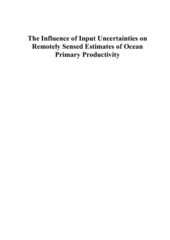| dc.description.abstract | Temporally and spatially dense estimates of oceanic phytoplankton net primary productivity (NPP), which are commonly derived by mathematical models from satellite observations of ocean colour, are a cornerstone of current research efforts focused on the state and variability of ecosystems, biogeochemical cycles and climate. Using two exemplary NPP models, it was examined how uncertainties in model input terms might affect the accuracy of the output. In the first part of the dissertation, the response of NPP estimates to perturbing input values of mixed layer depth (MLD) was analyzed. Four series of NPP fields, two global and two covering the North Atlantic, were computed in monthly intervals during a period of several years. Each of the series resulted from identical remote sensing data but different MLD input. Due to the influence of MLD on the availability of light for photosynthesis, the NPP estimates were overall inversely related to MLD. However, the degree of this relationship varied considerably in space and time over most of the world ocean. During summer, NPP at middle and high latitudes was appreciably sensitive even to small MLD fluctuations, but had little or no response to large MLD perturbations in winter. On the other hand, subtropical regions were characterized by a largely opposite seasonal pattern. Tropical areas showed no seasonality and, apart from the equatorial Pacific, exhibited little sensitivity of NPP to MLD uncertainties. The observed variability in the NPP response was attributed not only to the model’s nonlinearity, but also to the presence of the photosynthetic saturation/limitation thresholds, as well as to the coincident sea surface irradiance and, in particular, the diffuse attenuation coefficient for downward irradiance (Kd). It was shown that Kd could be used as an indicator of the NPP sensitivity to uncertainties in MLD, the greatest sensitivity being associated with very large Kd values. Maximum differences between areally integrated annual NPP estimates, based on different MLD input, were about 20– 30% in the North Atlantic subpolar gyre, about 15–20% in the eastern part of the North Atlantic subtropical gyre, and less than 10% over the global ocean. In the second part of the thesis, uncertainties in input terms were propagated through one of the most widely used NPP models via a Monte Carlo method, which enabled distinguishing between random and systematic uncertainty components. The study was based on monthly averaged global remote sensing observations from 2005. Although, due to computational requirements, the analysis was restricted to one year only, the results were remarkably stable in time and space, suggesting that they might also be valid for other years covered by the satellite observations. The typical distribution of uncertainty around the model output was lognormal-like. The average random uncertainty in NPP, expressed as the coefficient of variation, was 108%. The nominal NPP values in individual grid cells were typically overestimated by 6%, relative to the means of the associated uncertainty distributions. These positive systematic errors accumulated to an overestimate of 2.5 Pg C in the annual global NPP of 46.1 Pg C. The input quantity that contributed most to the systematic uncertainty in NPP was the parameter representing irradiance-dependent vertical changes in chlorophyll-normalized photosynthetic rates. On the other hand, the largest contributor to the random uncertainty in NPP was the term describing the physiological state of phytoplankton. Thus, reductions in the respective uncertainties in these two input terms could improve the accuracy of the NPP model the most. The final part of the thesis presents an analysis of uncertainty associated with a model of the euphotic depth (Zeu), which was developed for remote sensing applications and computes Zeu from the near-surface chlorophyll concentration. The analysis disregarded any uncertainty in the input chlorophyll values and concentrated only on the intrinsic uncertainty in the Zeu model. The latter was quantified by comparisons between the Zeu model output and reference values of Zeu, derived from in situ measured vertical profiles of downward irradiance. The Zeu model uncertainty, expressed in relative terms, complied well with a normal distribution. Due to an uneven geographical coverage of the in situ data set, the uncertainty statistics were weighted with a global Zeu climatology, obtained from remote sensing. This provided an estimate of positive bias equal to 9%. The remaining part of Zeu model uncertainty, which is associated with natural variability, amounted to 22% (expressed as the zero-centred root mean square difference). | en_US |
| dc.relation.haspart | Paper I: Global Biogeochemical Cycles 23, GB4005, Milutinović, Svetlana; Behrenfeld, Michael J.; Johannessen, Johnny A. and Truls Johannessen, Sensitivity of Remote Sensing–Derived Phytoplankton Productivity to Mixed Layer Depth: Lessons from the Carbon-based Productivity Model. Published version. Copyright 2009 American Geophysical Union. | en_US |

